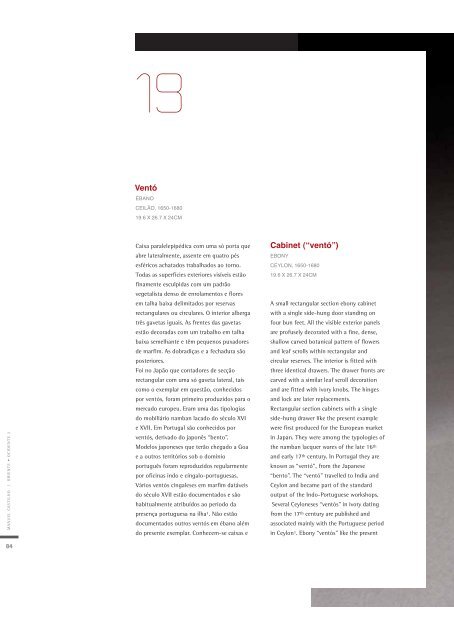ORIENTE OCIDENTE - Manuel Castilho Antiguidades
ORIENTE OCIDENTE - Manuel Castilho Antiguidades
ORIENTE OCIDENTE - Manuel Castilho Antiguidades
You also want an ePaper? Increase the reach of your titles
YUMPU automatically turns print PDFs into web optimized ePapers that Google loves.
MANUEL CASTILHO | <strong>ORIENTE</strong> • <strong>OCIDENTE</strong> 2<br />
84<br />
19<br />
Ventó<br />
ÉBANO<br />
CEILÃO, 1650-1680<br />
19.6 X 26.7 X 24CM<br />
Caixa paralelepipédica com uma só porta que<br />
abre lateralmente, assente em quatro pés<br />
esféricos achatados trabalhados ao torno.<br />
Todas as superfícies exteriores visíveis estão<br />
finamente esculpidas com um padrão<br />
vegetalista denso de enrolamentos e flores<br />
em talha baixa delimitados por reservas<br />
rectangulares ou circulares. O interior alberga<br />
três gavetas iguais. As frentes das gavetas<br />
estão decoradas com um trabalho em talha<br />
baixa semelhante e têm pequenos puxadores<br />
de marfim. As dobradiças e a fechadura são<br />
posteriores.<br />
Foi no Japão que contadores de secção<br />
rectangular com uma só gaveta lateral, tais<br />
como o exemplar em questão, conhecidos<br />
por ventós, foram primeiro produzidos para o<br />
mercado europeu. Eram uma das tipologias<br />
do mobiliário namban lacado do século XVI<br />
e XVII. Em Portugal são conhecidos por<br />
ventós, derivado do japonês “bento”.<br />
Modelos japoneses que terão chegado a Goa<br />
e a outros territórios sob o domínio<br />
português foram reproduzidos regularmente<br />
por oficinas indo e cíngalo-portuguesas.<br />
Vários ventós cingaleses em marfim datáveis<br />
do século XVII estão documentados e são<br />
habitualmente atribuídos ao período da<br />
presença portuguesa na ilha1. Não estão<br />
documentados outros ventós em ébano além<br />
do presente exemplar. Conhecem-se caixas e<br />
Cabinet (“ventó”)<br />
EBONY<br />
CEYLON, 1650-1680<br />
19.6 X 26.7 X 24CM<br />
A small rectangular section ebony cabinet<br />
with a single side-hung door standing on<br />
four bun feet. All the visible exterior panels<br />
are profusely decorated with a fine, dense,<br />
shallow carved botanical pattern of flowers<br />
and leaf scrolls within rectangular and<br />
circular reserves. The interior is fitted with<br />
three identical drawers. The drawer fronts are<br />
carved with a similar leaf scroll decoration<br />
and are fitted with ivory knobs. The hinges<br />
and lock are later replacements.<br />
Rectangular section cabinets with a single<br />
side-hung drawer like the present example<br />
were first produced for the European market<br />
in Japan. They were among the typologies of<br />
the namban lacquer wares of the late 16th and early 17th century. In Portugal they are<br />
known as “ventó”, from the Japanese<br />
“bento”. The “ventó” travelled to India and<br />
Ceylon and became part of the standard<br />
output of the Indo-Portuguese workshops.<br />
Several Ceyloneses “ventós” in ivory dating<br />
from the 17th century are published and<br />
associated mainly with the Portuguese period<br />
in Ceylon1. Ebony “ventós” like the present


